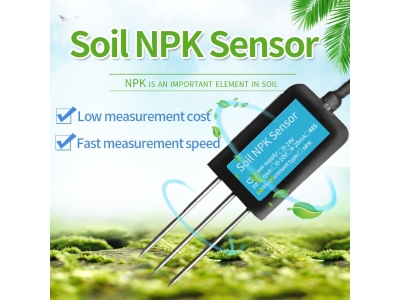In today's rapidly evolving agricultural landscape, farmers face the challenge of producing more food while conserving resources and minimizing environmental impact. One critical aspect of sustainable agriculture is efficient irrigation management. To achieve this, farmers can leverage soil sensor data, which provides valuable insights into soil moisture levels, nutrient content, and other essential parameters. This article explores how soil sensor data empowers farmers to make informed decisions in irrigation, ultimately leading to improved crop productivity and resource conservation.

The Importance of Informed Irrigation Decision Making:
Irrigation is vital for crop growth, particularly in areas with limited rainfall or unpredictable weather patterns. However, improper irrigation practices can result in water wastage, reduced crop quality, and increased production costs. Informed decision making based on accurate and real-time data is crucial for optimizing irrigation efficiency and achieving sustainable agricultural practices.
Understanding Soil Sensor Technology:
Soil sensors are advanced technological devices designed to measure various soil parameters, such as moisture content, temperature, electrical conductivity, and nutrient levels. These sensors are often placed at different depths within the soil profile to provide a comprehensive understanding of soil conditions. The data collected by these sensors is transmitted wirelessly, enabling farmers to monitor soil health and make informed decisions regarding irrigation practices.
Monitoring Soil Moisture Levels:
Soil moisture is a critical factor in determining irrigation needs. By using soil moisture sensors, farmers can accurately monitor and assess the moisture content at different soil depths. Real-time data from these sensors helps farmers understand how the soil moisture fluctuates throughout the day and the growing season. This information allows for precise irrigation scheduling, ensuring that crops receive the optimal amount of water without over-irrigation or water stress.
Optimizing Irrigation Timing and Frequency:
Soil sensor data enables farmers to optimize irrigation timing and frequency. By monitoring soil moisture levels, farmers can identify the ideal time to irrigate based on plant needs and soil water-holding capacity. This data-driven approach helps prevent both under-irrigation, which can lead to crop stress, and over-irrigation, which wastes water and increases the risk of nutrient leaching. Optimizing irrigation timing and frequency improves water use efficiency and promotes healthier crop growth.
Enhancing Nutrient Management:
Soil sensor data provides valuable insights into soil nutrient content, allowing farmers to optimize fertilizer application. By monitoring nutrient levels, farmers can identify deficiencies or excesses and adjust fertilization accordingly. This targeted approach ensures that crops receive the necessary nutrients for optimal growth while minimizing environmental pollution caused by nutrient runoff. Leveraging soil sensor data enables farmers to implement precision nutrient management, leading to improved crop productivity and reduced fertilizer costs.
Managing Soil Salinity:
Soil salinity is a significant concern in many agricultural regions, as it can negatively impact crop growth and yield. Soil sensors equipped with electrical conductivity probes can measure soil salinity levels accurately. With this information, farmers can identify areas with high salinity and adjust their irrigation practices accordingly. By implementing strategies such as leaching excess salts or using alternative water sources, farmers can mitigate the adverse effects of soil salinity and maintain healthy crop growth.
Real-time Data Insights and Precision Agriculture:
The real-time data provided by soil sensors empowers farmers to embrace precision agriculture techniques. By analyzing historical data trends, farmers can identify patterns, optimize irrigation schedules, and adjust water usage based on crop needs. This data-driven decision-making approach maximizes irrigation efficiency, minimizes resource wastage, and improves overall farm productivity. Leveraging soil sensor data paves the way for precision agriculture, where farmers can make informed decisions tailored to their specific soil and crop conditions.
Conclusion:
Soil sensor data plays a crucial role in empowering farmers to make informed decisions in irrigation. By monitoring soil moisture, optimizing irrigation timing and frequency, enhancing nutrient management, and managing soil salinity, farmers can achieve efficient water use, improve crop productivity, and promote sustainable agricultural practices. Embracing soil sensor technology enables farmers to navigate the complexities of irrigation management and maximize resource utilization. Ultimately, leveraging soil sensor data is instrumental in empowering farmers to meet the global demand for food while minimizing environmental impact and ensuring long-term agricultural sustainability.






